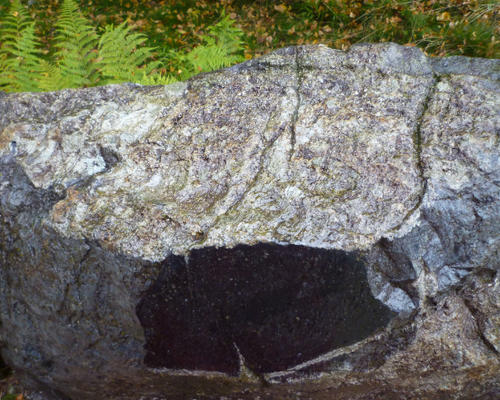Transformation processes and deformations of oceanic rocks
Serpentinite (dark) in a gneiss
Image Credit: Franzfoto CC BY SA 4.0
Rocks that were once formed in the oceans can be found on continents all over the world. Since their formation, these rocks have undergone a variety of changes caused by chemical transformation processes or deformation. In the case of the rock ophicalcite, much can be learned about the processes involved by studying the chemical evolution from the original serpentinite to the formation of ophicalcite.
The data
The dataset contains different types of geochemical data. These include concentrations of major and trace elements, rare earths, data on radiogenic isotopes of strontium and on stable isotopes of hydrogen and oxygen. Serpentinites and ophicalcites from the ophiolite sequence of the northern Apennines in Italy were investigated.
In addition, chemical data of individual minerals of the rocks (serpentine, amphibole, chlorite and talc) are available in the data set. The carbonate veins of the ophicalcite were also investigated: radiogenic strontium isotopes as well as stable carbon and oxygen isotope data were collected.
Publication of the dataset: Schwarzenbach E, Vogel M et al (2020) https://doi.pangaea.de/10.1594/PANGAEA.921741
Research results
In the present case, ophicalcite from the northern Apennines in Italy was studied, which was formed as serpentinite on an ocean ridge about 170 million years ago, in the Jurassic. The data allow new, comprehensive insights into the hydrothermal and temporal evolution of these ophiolite rocks and the origin of the fluids that caused the rock transformation. The chemical signatures in the rocks are the result of a complex interplay of different processes of rock alteration (serpentinisation, carbonisation and metasomatism).
The multiphase interaction between water and rocks involves the intrusion of fluids from the basement during the initial upwelling of the mantle in an opening ocean basin. This was followed by local intrusion of high-temperature fluids and extensive seawater circulation in the rock, leading to carbonisation. Later, fluid-rock interaction with the overlying iron- and magnesium-rich rocks led to Si enrichment in the ophicalcite.
The study compares the formation of the Appenine ophicalcites with the hydrothermal system of the Atlantis Massif, which is a modern analogue for the North Appenine ophiolites. The comparison of an ancient hydrothermal system with one of more recent geological time allows a better understanding of the chemical evolution of the oceanic lithosphere. The sequence studied is an excellent example of the evolution of serpentinite to ophicalcite during the continuous uplift and exposure of ultramafic rocks on the seafloor and documents the complex hydrothermal evolution of ultramafic rocks associated with this process.
Publication of the journal article: Schwarzenbach E, Vogel M et al (2020) https://doi.org/10.1029/2020JB020619
Texts modified after: Schwarzenbach E, Vogel M et al. (2020) https://doi.org/10.1029/2020JB020619
